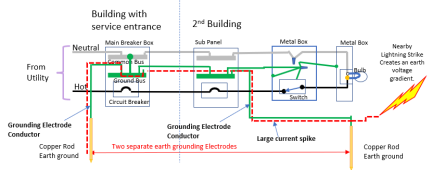Why would it create a lightning strike issue?
When lightning strikes nearby, it can cause a huge voltage gradient across the ground. The two electrodes and connecting wires become a current path that can carry a huge current spike.

The problem is that the large spike can arc to other parts of the circuit and can also create spikes on the neutral and hot due to inductive and/or capacitive coupling.
I do not understand any of this super well, but my general understanding is that a lot of the code is there to keep the chance of losing a ground to a minimum.
I am trying to understand failure modes on this and I am not following the argument.
The primary purpose of tieing a circuit to earth ground is to prevent a large potential between the circuit and earth. Very early on they figured out that letting circuits float and develop these potentials was hard on the equipment.... so they started tieing circuits to the ground.
If only the ground wire is broken between the buildings, the hot and neutral are still tied to earth back at the main building. Having a grounding electrode tied to the disconnected part of the grounding circuit does not change anything.
The big problem with disconnects is if either Ground or Neutral is disconnected but Hot is not. In this case, the circuit no longer 'sees' the NG bond so a short to exposed metal will not clear the fault. Adding a grounding electrode at the outbuilding does not fix this. (The earth ground resistance is too high to clear a fault.)
I keep thinking the reason for the 2nd electrode has something to do with the inductance of the ground wire back to the main building. If the inductance is high, it might prevent a high-frequency pulse from passing through to the main building.. but the Hot and neutral lines would have the same issue. I can't figure out how the 2nd electrode fixes anything.
Almost without exception, if I do not understand the purpose of an NEC requirement I just assume there is a case I don't understand. In this instance, I have done a deep dive on it and simply can't find an explanation for the requirement.




